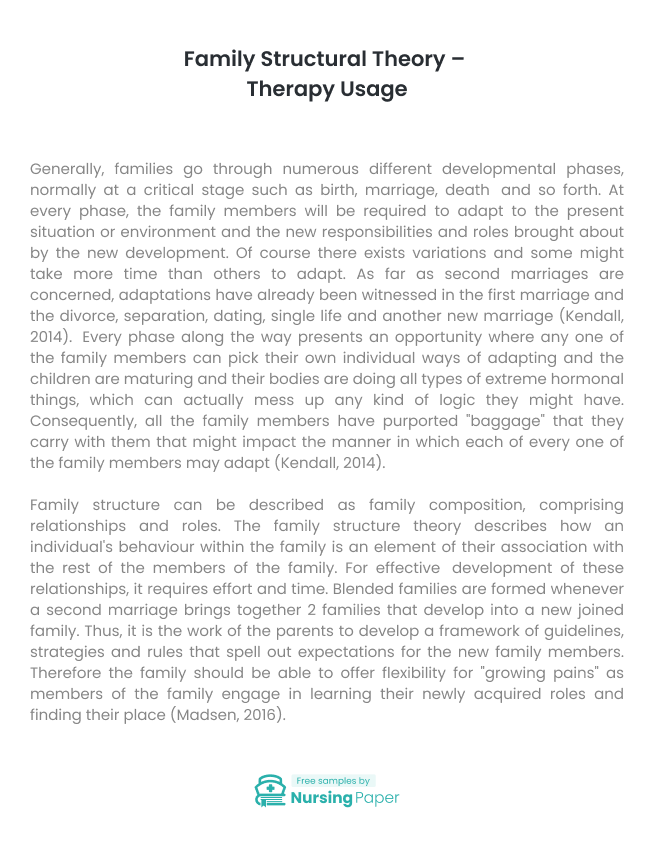
Family Structural Theory – Therapy Usage
Introduction
Generally, families go through numerous different developmental phases, normally at a critical stage such as birth, marriage, death and so forth. At every phase, the family members will be required to adapt to the present situation or environment and the new responsibilities and roles brought about by the new development. Of course there exists variations and some might take more time than others to adapt. As far as second marriages are concerned, adaptations have already been witnessed in the first marriage and the divorce, separation, dating, single life and another new marriage (Kendall, 2014). Every phase along the way presents an opportunity where any one of the family members can pick their own individual ways of adapting and the children are maturing and their bodies are doing all types of extreme hormonal things, which can actually mess up any kind of logic they might have. Consequently, all the family members have purported “baggage” that they carry with them that might impact the manner in which each of every one of the family members may adapt (Kendall, 2014).
Family structure can be described as family composition, comprising relationships and roles. The family structure theory describes how an individual’s behaviour within the family is an element of their association with the rest of the members of the family. For effective development of these relationships, it requires effort and time. Blended families are formed whenever a second marriage brings together 2 families that develop into a new joined family. Thus, it is the work of the parents to develop a framework of guidelines, strategies and rules that spell out expectations for the new family members. Therefore the family should be able to offer flexibility for “growing pains” as members of the family engage in learning their newly acquired roles and finding their place (Madsen, 2016).


The Family Structural Theory developed by Minuchin is a model that offers definite therapeutic methods that the structural family therapist might use in transforming patterns, systems, as well as communication systems in the family. Most of the time, second marriages need frequent shifting of family tasks when there is division among children or are part of 2 or more family groups leading to changes in the entire family (Kendall, 2014). Thus, for example parents and children might have impractical anticipations and various behavioural patterns and even various loyalties to one another and the entire family in general. Therefore, one family might permit certain communications and behavior while the newly formed second family the same child is a member of might develop contradictory expectations and rules. Changes such as these result in stress and might be expressed by dysfunctional family relationships as well as communication (Madsen, 2016).
The Family Structural Theory enables the therapist in not only observation but also at times become a member of the family interactions for a short-time, so as to assess what patterns are detrimental and assist in providing a different more beneficial venue for the family to interact. The therapist thus is similar to a “technician with zoom lens”, ensuring structural dysfunction based on observation made in the room (Madsen, 2016). The advantage lies in the fact that there is no hearing of someone’s opinion regarding how ‘dad’ is very unfair, or how one child is being picked on, but for the therapist to essentially make observations of these interactions in real time. The therapist, of course, should remain decentralized and objective as s/he gives directions to the family toward productive interaction as well as good psychosocial working (Madsen, 2016).
Eventually, this therapy is useful for second marriages families since failures and success of family communication, is easily observed and assessed, thus permitting for current productive transformations, shifts and development within family structures.

1. Madsen, W. C. (2016). Collaborative therapy with multi-stressed families. New York: Guilford Press.
2. Kendall, D. (2014). Sociology in Our Times: The Essentials. New York: Wadsworth.



The download will start shortly.

The download will start shortly.
 Subject:
Medicine
Subject:
Medicine  Number of pages: 6
Number of pages: 6  Subject:
Health and Social Care
Subject:
Health and Social Care  Number of pages: 3
Number of pages: 3  Subject:
Nursing
Subject:
Nursing  Number of pages: 3
Number of pages: 3  Subject:
Nursing
Subject:
Nursing  Number of pages: 2
Number of pages: 2  Subject:
Health and Social Care
Subject:
Health and Social Care  Number of pages: 4
Number of pages: 4  Subject:
Medicine
Subject:
Medicine  Number of pages: 3
Number of pages: 3  Subject:
Health and Social Care
Subject:
Health and Social Care  Number of pages: 3
Number of pages: 3  Subject:
Health and Social Care
Subject:
Health and Social Care  Number of pages: 5
Number of pages: 5  Subject:
Nursing
Subject:
Nursing  Number of pages: 6
Number of pages: 6  Subject:
Health and Social Care
Subject:
Health and Social Care  Number of pages: 3
Number of pages: 3  Subject:
Health and Social Care
Subject:
Health and Social Care  Number of pages: 5
Number of pages: 5  Subject:
Health and Social Care
Subject:
Health and Social Care  Number of pages: 4
Number of pages: 4  Subject:
Medicine
Subject:
Medicine  Number of pages: 7
Number of pages: 7  Subject:
Health and Social Care
Subject:
Health and Social Care  Number of pages: 4
Number of pages: 4  Subject:
Health and Social Care
Subject:
Health and Social Care  Number of pages: 2
Number of pages: 2 
